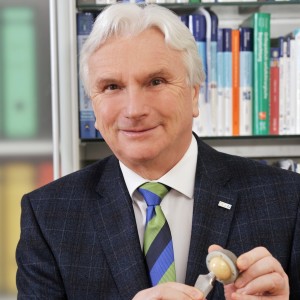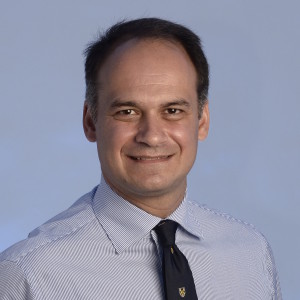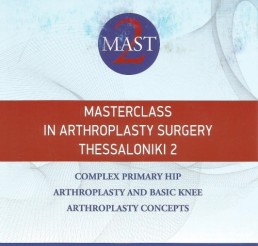
Letter from the President, Prof Werner Siebert
Dear Members,
It is time for the annual EFORT congress once again, this time in Switzerland’s beautiful Geneva. I hope that many of you will be able to come and attend one of EHS’s many activities there. We have the EHS Register Symposium, Speciality Sessions, an Advanced Course in Total Hip Replacement and a debate on Cemented Versus Cementless Primary THA in +70 Years. Many top names from EHS will be chairing, moderating and presenting these events.
Please, if you are in Geneva, come along to the EHS stand and visit us. You can also pick up your Preliminary Programme for our EHS Congress in Munich in September. And of course, if you can’t fit Geneva into your schedule, we will keep you updated on our activities there through our new website, facebook and of course the EHS Newsletter.
Your EHS President, Werner Siebert
Letter from the Secretary General, A Prof Eleftherios Tsiridis
As every year, the European Hip Society will have a booth at the EFORT Congress (C2-38), so please come and find us. It is always good to meet face to face and discuss anything “hip”.
This issue of the EHS Newsletter, Number 19, marks the completion of our project for every EHS Nat Rep to write a summary from their country. Thank you very much to you all. A few International Members from outside Europe have contributed too, and we will continue to ask them to do so.
We will now start to include summaries from EHS Members themselves. So if you would like to send in a contribution for this newsletter, we’d be delighted to receive it.
This issue also sees our 2nd Q&A supplement, this time we hear about the MAST 2 Course which took place in Thessaloniki late last year, with words from myself and EFORT’s Secretary General and Orthopaedics Today Europe’s Chief Medical Editor, Prof Per Kjaersgaard-Andersen. Scroll down to read it in full.
EHS Secretary General, A Prof Eleftherios Tsiridis

The UK has led the way in monitoring the performance of joint implants by initiating the system known as the ODEP in 2003
Evert Smith, Nat Rep for UK
NATIONAL REPRESENTATIVE FOR UNITED KINGDOM: Evert Smith
Since the National Joint Registry (NJR) for England, Wales, Northern Ireland and the Isle of Man was set up in 2003, more than 1.8 million hip procedures have been recorded to March 2015. There has been a trend away from cemented hip replacements from NJR inception, the most common fixation now being uncemented with a slight rise of hybrid fixation. Ceramic-on- polyethylene articulations have the lowest revision risk.
The UK has led the way in monitoring the performance of joint implants by initiating the system known as the Orthopaedic Data Evaluation Panel (ODEP) in 2003. As a result of a significant incidence of associated device-related adverse events from certain brands during the initial phase of product launch prior to widespread use, a further layer of surveillance known as Beyond Compliance (BC) was launched in 2014.
Whereas ODEP is concerned with the performance of an implant once it is available to market, BC comprises of a specialist team that monitors early results and analyses these until sufficient data has been obtained and successful results evidenced.
The UK’s ODEP model has received worldwide acclaim and other countries have copied this model. ODEP was acknowledged in the 2014 Swedish Hip Arthroplasty Register.
Patients’ expectations are changing, prevention and treatment of complications are improving, research is growing
Luigi Zagra, Nat Rep for Italy
NATIONAL REPRESENTATIVE FOR ITALY: Luigi Zagra
Hip topics are getting increasing interest in the Italian orthopaedic community as a new generation of younger hip surgeons have been growing in the last years. Joint preserving surgery, not only arthroscopic, after a pioneer time has shown its effectiveness and limitations. With a better understanding of the hip biomechanics and pathologies and the correct indications, this surgery has gained the right role in the hands of selected surgeons. Revision surgery is increasing in number of procedures and thanks to the new technical tools, it is feasible in the hands of more skilled surgeons in the major centres. Very good primary THA are performed in most of the orthopaedic departments as the surgical techniques and materials and the less invasive approaches have shown all the advantages. After the latest “fashions” the real benefits and limitations of the innovation are clearer. Patients’ expectations are changing, prevention and treatment of complications are improving, research is growing. The Combined Meeting of the Italian and British hip societies last November with the active participation of many EHS members was a good example of this time of progress through collaboration. We are looking forward to our next Domestic Congress in September in Munich.
Luigi Zagra, EHS Past President and Italian National Representative
EHS: Q&A
Masterclass in Arthroplasty Surgery Thessaloniki 2
4-5.12. 2015 – Thessaloniki, Hellas
Complex Primary Hip / Arthroplasty and Basic Knee / Arthroplasty concepts
MAST: A Prof Eleftherios Tsiridis EFORT: Prof Per Kjaersgaard-Andersen
-
What is the Masterclass in Arthroplasty Surgery?
MAST: The MAST Course is an international mini professional conference aiming to continuously educate young or even experienced surgeons in arthroplasty surgery. It has a very experienced international and national faculty and also involves experienced surgeons from Exeter to teach the Exeter Hip Course in cemented hip arthroplasty.
EFORT: A course where young, up and coming joint replacement surgeons over a two days course are educated by experienced orthopaedic senior surgeons in various aspects of treating patients with basic and complex primary hip and knee arthroplasties.
-
Was it a success?
MAST: This is the 2nd time we run this course and we are aiming for the 3rd one in December of this year. The course is under the auspices of EFORT, EHS, The Hellenic Association of Orthopaedics and Trauma and the Aristotle University Medical School. It is now considered an international conference and has attracted candidates form Southeast Europe and the neighbouring countries.
EFORT: Yes, when the young trainees – after the course – are ready to recommend that same course for their fellow colleagues.
-
How did the Masterclass benefit from the auspices of EFORT?
MAST: EFORT is the largest European organization in orthopaedics and we enjoy and respect enormously their contribution and their recognition of the Mast Course. We make every possible effort to maintain their auspices for good and make the Mast Course and Thessaloniki an official EFORT educational centre in a network of centres around Europe.
EFORT: By the attendance of EFORT’s Secretary General to learn if this course in any way can be integrated in the overall educational EFORT programme.
-
Considering topics of the Masterclass: what is the most important issue in Complex Primary Hip?
MAST: The most striking lectures were first on the management of complex primary arthroplasties that require experience and planning and second, the 24 hours arthroplasty service that remains a primary target of the national health services.
EFORT: To learn when a case is complicated, so you as young hip surgeons do not start out without being well prepared. Next to learn about tips and tricks in the complicated primaries.
-
What is the “burning issue” in Arthroplasty Concepts?
MAST: The most burning issue is the cost effectiveness of joint arthroplasty and the lack of classification of appropriateness for joint replacement in the population.
EFORT: For me it is the “Cemented Paradox” – where the outcome of most national registries clearly prove the well cemented THA to have a significantly higher survival rate – and yet, still, hip surgeons across the world are using more and more frequently the non-cemented designs. Why is that?? Industry-driven?? Driven by “quicker surgery” – or what else? That is for me the current most burning issue within THA.
-
Is Cement and the Cemented THA a hot topic?
MAST: Absolutely. It appears quite clearly now that cemented femoral prosthesis is the appropriate one, with significant longevity in the over 60s, as well as for proximal femoral deformities in young people. Uncemented hips remain a gold standard procedure for the uncomplicated straightforward routine hip arthroplasty, however, this procedure must always be performed by experienced surgeons as it cannot forgive any intraoperative surgical mistakes.
EFORT: As mentioned above it is definitely a hot topic. The THA era started with the total cemented THA – and has developed from that. We today forget why hip surgeons in the 70’s and 80’s went away from cemented THA – namely mainly due to what they thought was “cement-disease” – later shown to be a combination of poor cementing techniques and poor first and second generation polyethylene. On top of this THA – and mainly the non-cemented THA became the “big business” – and industry and supported by some hip surgeons brought that into a world-wide big money business. Today we have developed 4-5 generation cement and cementing technique – has clearly better implants for cementing – and a much better polyethylene with no or only minor wear. So all good indications are there for turning more and more of our cases into a total cemented THA.
-
What did attendees learn about Tribology and Interface?
MAST: The hot topic nowadays is the trunnion disease and the metal and metal tribology issues. Manufacturing diversity, design and head size has changed the outcome of a standard hip procedure that all must be under control. Regarding materials, the literature and sciences over such, rated with good quality materials and the tribology issues are now resolved with guaranteed longevity of up to 30 years.
EFORT: The attendees had basic information on tribology, third body wear, interface fixations – and how these may both develop in different designs and bearings – and influence the outcome / survival of an implant / design.
-
Were Complex Primary Femur and Complex Primary Acetabulum discussed?
MAST: It was discussed thoroughly in the special session on complex arthroplasty and several techniques were deployed according to several clinical case scenarios. The discussion was really revitalising, bringing along ideas and practices from around Europe.
EFORT: Certainly – in several presentations. It was the main theme of the Course.
-
Finally, when will the next Mast Course be?
MAST/EFORT: It is held always in the first weekend of December, which this year is between 2nd and 4th of December 2016. The place is the magnificent opera house on the seafront in the heart of Thessaloniki.








